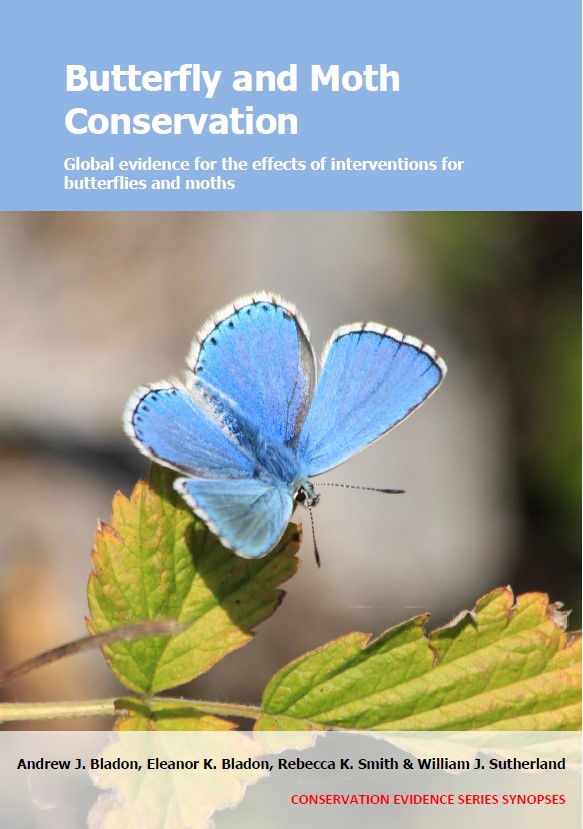Change type of livestock grazing
-
Overall effectiveness category Awaiting assessment
-
Number of studies: 4
View assessment score
Hide assessment score
How is the evidence assessed?
-
Effectiveness
not assessed -
Certainty
not assessed -
Harms
not assessed
Study locations
Supporting evidence from individual studies
A replicated, site comparison study in 1993 in 34 fen meadows in Glamorgan, UK (Lewis & Hurford 1997) found that changing the type of livestock grazing did not affect marsh fritillary Eurodryas aurinia population size. There was no significant difference in the proportion of cattle-grazed (3/9), horse-grazed (2/6), sheep-grazed (0/2), unmanaged (4/8), burned (5/8 sites), and mown (0/1) sites that had >20 caterpillar webs recorded. However, the three largest populations (>200 caterpillar webs) were on sites burned in early spring. Caterpillar webs were present on 28/34 sites where adults had been recorded in May/June. In 1993, nine grasslands were cattle-grazed, six were horse-grazed, two were sheep-grazed, eight were unmanaged, eight were burned, and one was mown. Sites were separated by >1 km of unoccupied grassland, or >0.5 km of unsuitable habitat. From late August–mid-October 1993, caterpillar webs were surveyed on 34 fen grasslands. On sites <2 ha, all devil’s bit scabious Succisa pratensis were searched in 2-m-wide parallel strips until the whole area had been searched. On larger sites, 2-m-wide strips at 10-m intervals were searched, and areas around caterpillar webs were then searched comprehensively.
Study and other actions testedA replicated, paired, site comparison study in 2003–2004 in 36 semi-natural grasslands near Lund, Sweden (Öckinger et al. 2006) found that grasslands grazed by cattle or horses had a greater species richness of butterflies and burnet moths than grasslands grazed by sheep. Sites had a greater species richness of butterflies and burnet moths if they were currently grazed by horses (13 species) or cattle (12 species) compared to sites grazed by sheep (7 species), and were similar to sites with no grazing (12 species). From 1999–2003, twelve abandoned, semi-natural grasslands were restored by clearing trees and shrubs, erecting fences, and re-introducing grazing animals. Butterflies and burnet moths were surveyed using transects (150 m/ha) six or seven times in May–August 2003 or June–August 2004 on 12 restored grasslands, 12 continuously grazed semi-natural grasslands and 12 abandoned grasslands. Under current management, 12 sites were cattle grazed, six were horse grazed, eight were sheep grazed and 10 had no grazing.
Study and other actions testedA replicated, randomized, paired, controlled study in 2007–2008 in a meadow steppe grassland in Jilin Province, China (Zhu et al. 2015) found that plots grazed by cattle, goats or sheep all had a similar abundance of butterflies and moths, but the abundance was lower than on ungrazed plots. After a year and a half of grazing, the abundance of butterflies and moths was similar on plots grazed by cattle (2–7 individuals/plot), goats (3–7 individuals/plot) or sheep (3–6 individuals/plot), but was lower on all grazed plots than on ungrazed plots (6–22 individuals/plot). Nine 0.3-ha blocks were each divided into four fenced, 0.05-ha plots, 18–20 m apart, to which four grazing treatments were randomly assigned. From July 2007 and 2008, plots were either grazed by two cattle, eight goats, or eight sheep, or left ungrazed. Grazing was conducted for two hours each morning and evening, until 60% of forage was removed (10–15 days/month, number of months not given). From July–October 2008, insects were surveyed four times by walking two 25-m-long transects/plot, twice/day, and taking 15 sweeps/transect through the vegetation with a 40-cm diameter net. All adult insects were identified to species.
Study and other actions testedA replicated, randomized, controlled study in 2011–2013 in semi-natural mountain pastures in Massif Central, France (Ravetto Enri et al. 2017) found that plots grazed by cattle had a higher abundance and species richness of butterflies and burnet moths than plots grazed by sheep. In plots grazed by cattle, the abundance (37 individuals/plot) and species richness (9.1 species/plot) of butterflies and moths was higher than in plots grazed by sheep (abundance: 22 individuals/plot; richness: 6.4 species/plot). From 1992–2011, pastures were grazed extensively by cattle without fertilization. From May–October 2011–2013, six 3.6-ha plots were each grazed by seven Charolais cattle (heifers), and six 0.6-ha plots were each grazed by seven female Limousine sheep (both 1.75 livestock units/ha). Three plots in each group were grazed continuously, and three were sub-divided into four subplots each grazed for 35 days/year. One subplot in each plot was not grazed for 63 days from early June–early August each year. From early July–early August 2011–2013, butterflies and burnet moths were surveyed twice/year on four 50-m fixed transects/plot (one in each rotational subplot).
Study and other actions tested
Where has this evidence come from?
List of journals searched by synopsis
All the journals searched for all synopses
This Action forms part of the Action Synopsis:
Butterfly and Moth Conservation
Butterfly and Moth Conservation - Published 2023
Butterfly and Moth Synopsis





)_2023.JPG)














